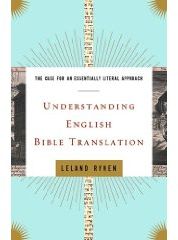Review: Understanding English Bible Translation: The Case for An Essentially Literal Approach.
Understanding English Bible Translation is an important book. It is published by Crossway, which also publishes the popular English Standard Version (“ESV”) translation of the Bible. And it was authored by Leland Ryken, a consultant to that translation. So the book is as official a justification of the ESV and its translation philosophy as can be obtained.
Unfortunately, Ryken’s work is marred by a disdain for scholarship, rhetoric disguised as argument, and a lack of attention to the very biblical text he claims to be investigating.
On page 28, Ryken sets the tone for his book with the bold statement that “we should not allow the high-flown technical jargon of linguistics deter [sic] us from seeing what is plain to us.” In other words, if readers think one thing, and linguists think something else, readers should assume that the linguists are wrong.
One of the main thrusts of Ryken’s book is that the domain of translation should essentially be limited to the word. Ryken claims on pp. 23-24 that, “translators must decide what English word or phrase most closely corresponds to a given word of the original text” (my italics). He thus frames the issue of translation asymmetrically, assuming that each Greek or Hebrew (or Aramaic) word of the Bible should be translated into English by itself, even though he recognizes that it may take an entire English phrase to do so. It is a bold and unorthodox suggestion, but when Ryken dismisses the mainstream counterclaim as mere “high-flown technical jargon” is it hard to evaluate his claim, let alone accept it.
Ryken’s term for this translation philosophy of his is “essentially literal translation,” by which he means (pp. 19-20): “a translation that strives to translate the exact words of the original-language text” (this is the “literal translation”) but “not in such a rigid way as to violate the normal rules of language and syntax in the receptor language” (this is where he gets the modifier “essentially”).
I no longer actively write this blog, but you can find me at Ancient Wisdom, Modern Lives
Subscribe Now I'd love to see you there!Language theorists such as Hilary Putnam and W.V.O. Quine agree that words in isolation do not have inherent meaning, and translation theorists from Horace to Vladimir Nabokov (who changed his mind on the matter) agree that word-for-word representations are not translations. Ryken disagrees with these scholars and practitioners.
But in place of solid argument in favor of his approach or even against competing theories, Ryken provides the reader with rhetoric, and in this regard Ryken excels. His statement on p. 91 that confidence in a translation comes “[w]hen essentially literal translators preserve the words of the original authors” demonstrates. Rather than convincing the reader that essentially literal translation preserve anything, he assumes the fact, and uses it in eloquent prose.
Similar though less subtle is his definition of “linguistic conservatism” (his approach), which offers (p. 20) “an implied contrast to the ‘liberalism’ of dynamic equivalence, which does not feel bound to reproduce the actual Hebrew and Greek words” (my italics). The snide slight “does not feel bound” contrasts with his praise for essentially literal translation, as for example on p. 131, where he states that committees that adopt the latter strategy, “keep their eye on what the original text says” (my italics). On p. 33, Ryken pits essentially literal translation against other approaches by what he calls, “[f]idelty to the words of the original vs. feeling free to substitute something in place of those words.” Even in the phrasing, we see Ryken’s bias.
We also see his rhetorical skill. The book is replete with well-crafted prose, as for example on p. 133. When readers learn that white garments and oil were signs of celebration in antiquity, Ryken suggests, they “experience a pleasant addition to their fund of knowledge and a salutary reminder that not everyone who has lived has done things the way we do them.” Ryken’s writing is clear and articulate, and is matched by the clear and careful organization of his book.
Nonetheless, in using rhetoric instead of evidence to frame the debate, Ryken makes it hard to focus on any real issues of theory.
Perhaps most disappointing, though, are Ryken’s examples of “success.”
On p. 58, Ryken condemns the Good News Bible (“GNB”) for changing “red pottage” in Genesis 25:30 into “red stuff.” Yet the original Hebrew does not contain any word that might be translated as “pottage.” It is not clear why Ryken’s own theory wouldn’t prefer the GNB here. (The translation “pottage” dates back to the 3rd century B.C., when the LXX added the word epsema to elucidate the passage.)
On the next page, Ryken laments the “change” in Psalm 1 from “Blessed is the man…” (RSV, my italics) to “Happy are those…” (GNB, my italics), noting that “[t]he RSV stays very close to its KJV model” while “[s]omeone reading the Good News Bible for the first time must have been shocked by the contrast.” Yet, the Hebrew word here, ashrei, is most naturally translated as “happy,” not “blessed,” and the KJV often translates the same word as “happy” elsewhere (Psalm 128:1, Psalm 137:8, Psalm 146:5, etc.).
And again on pp. 112-3, Ryken notes the felicity of the ESV translation of Psalm 192, commending the wording “You know when I sit down and when I rise up” in verse 2 and the wording “You search out my path and my lying down.” Yet all four of the phrases I italicize here are nouns in Hebrew. Ryken doesn’t tell the reader why “…my sitting down and my rising up” wouldn’t be better. (The KJV “my uprising” is clearly wrong in today’s English.)
Chapter 14 addresses “oral reading of the Bible,” and here Ryken praises the KJV as “incomparably the best English translation in regard to rhythm,” though he does “not have leisure to explain” why. He does give some examples, though, and while one might agree or disagree about the poetic and metrical merits of the translations he compares, Ryken doesn’t address the broader and more important question: Is the good or bad rhythm a good or bad translation?
Ryken values fidelity, as we read in the rhetorical question on p. 29: “What good is readability if the result is not what the biblical writers said?” The careful reader might equally ask, “what good is rhythm if it is not what the biblical writers wrote?” — particularly in light of what Ryken explains on p. 155: “Hebrew poetry was not based on regular meter as English poetry is.” There may be some good answers, but Ryken does not address the issue.
In general, one gets the impression that Ryken’s is a personal, impassioned defense of the KJV, rather than a discussion of its merits. The examples above (“red stuff” versus “red pottage” and “blessed” versus “happy”), and many others, show his preference for the KJV even over the original text. Ryken also includes two whole chapters on the history leading up to the creation of the KJV, even noting (p. 38): “For people who have multiple English Bibles on their shelves, it is important to be reminded that the vernacular Bible was begotten in blood.”
On p. 61, Ryken repeats his plea to ignore scholarship, this time claiming: “We do not need to conduct a scholarly exploration…. We can hear the difference [in translations] immediately.” His point is that new translations are different than the KJV, so they must be wrong. His discussion there never refers back to the original language of the Bible. His point is that translations that are closer to the KJV are inherently better.
Still, Ryken offers three points that merit careful attention.
First, on p. 128, Ryken suggests that, “[t]he theological language of the Bible needs to match the language of our theology books,” and further suggests (without evidence, though I believe he is probably correct) that essentially literal translations do a better job.
The last chapter of the book offers two more non-accuracy-related reasons to favor Ryken’s approach: It may produce a more stable English translation (“the variability among English Bible translation [used to be] within the normal range of lexical tolerance,” p. 164). And — regardless of the original Hebrew and Greek — perhaps a translation needs to be exalted in order to be effective, or, as Ryken puts it (p. 172), “some translations preserve the commanding dignity of the King James tradition.”
In essence, these three points argue that an essentially literal translation may be desirable regardless of any (in)accuracies. It’s an interesting issue that deserves a fuller treatment, but, again, Ryken’s lack of attention to detail leaves the reader wanting more information.
In spite of these significant shortcomings, Ryken does a good job pointing out some specific and even systematic insufficiencies of translations such as The Message and the GNB. He also summarizes the misplaced goals of some of these translations: They translate into simple English even when the original is complex. They remove poetic imagery. They dumb down the text. They decide what the English should sound like without taking the original into account.
Yet even here, Ryken’s comparisons are to the KJV and to other translations in that tradition, so it is difficult for readers who have not mastered Hebrew and Greek to evaluate his claims. (And on p. 39 Ryken commends Tyndale for his “devotion to clarity.” The reader wonders why Tyndale’s devotion to clarity is beneficial, while the seemingly similar approach of the GNB is not.)
Ryken recognizes (p. 18) a continuum of “increasing boldness in departing from what the original biblical text actually says, starting with the NIV [New International Version] and culminating with The Message.” His inclusion of the NIV in this list is particularly unfortunate, and it is hardly an accident that in later parts of the book, he groups the NIV with his “good” translations.
Yet in spite of this misstep, Ryken correctly identifies a clustering of goals that are embodied by various schools of translation, which he collects in his chart on p. 33. As a general guide, for example, translations that tend toward gender accuracy also tend toward simplified language (though there are exceptions). With a more solid grounding in theory, this could have been a much more valuable presentation, but as it is, Ryken’s careful comparisons — like much of the book — are mixed with unsupported theoretical claims and inattention to accuracy.
So Understanding English Bible Translation: The Case for an Essentially Literal Approach summarizes some specific deficiencies in some Bible translations and offers a glimpse at their underlying philosophies, but it does not provide the larger framework the title promises, nor the evidence to support the subtitle. And even though it shows that the ESV is closer in nature to the KJV, it does not offer any convincing reason beyond personal preference to choose the ESV or any other essentially literal translation. This is a shame, because the ESV is one of the best-selling translations, and a solid exploration of its potential merits — one which takes careful note of the original Hebrew and Greek, and which incorporates rather than dismisses current translation theory — would be most welcome.
Bible essentially literal translation ESV KJV review Ryken translation







11 Responses
I’m glad you’ve taken the time to do this. I thought about it, but decided it wouldn’t be worth it to open to the first page. I knew already what I would find — and I was right.
by the way, it needs to be clear what kind of consultant Ryken was: a *English* literary consultant. He doesn’t know Greek or Hebrew and he’s not trained in linguistics & translation — something he consider one of his big strengths.
He’s a gifted literary critic & English writers. I’ve read several of his essays & his major work on Milton’s Paradise Lost with much enjoyment. But this is not his field and it’s clear.
[…] Hoffman writes: Unfortunately, Ryken’s work is marred by a disdain for scholarship, rhetoric disguised as […]
Joel I’m confused.
I feel strongly that word for word representations are not translations in the true sense.Anyone who has to pray the psalms from the 1662 prayer book soon sees that!
I struggle (as someone with academic and practical qualifications in linguistics, translation and theology) to find any engagement with someone like Ryken (wasn’t he in Star Trek?) who would obviously consider me a monstrous liberal.
As I recall, the concept of dynamic equivalence originates historically from the Christian mission field, as those engaged with translating the Bible wrestled with the task of conveying Biblical concepts and customs to their host culture, which in all likelyhood was very different from that of the ANE or 1st Century Palestine.
To reject this in favour of an infantile building block approach like “essential literalism” would be (it seems to me) to reject the foundational principle of Bible translation – to enable others to hear the good news in a language they understand.
This is what Jerome, Tyndale, Wyclif and Cranmer wanted; it is what the GNB, the NLT and the Message (which I don’t think has ever overtly claimed to be a translation btw)intend. For me Bible translation is not about perfection of language, it’s about telling the good news.
One of the things that steered me away from Bible translation as a vocation was the disproportionate amount of work that goes into doing English versions, when there are still many many languages and dialects with NO scriptures available to native speakers. Do we really need another NIV or a Klingon Bible?
I’m also confused about what you really think, as you seem to demolish the approach and content of the book, then at the end you say you agree with Ryken about essentially literal translations (or did I misunderstand you?)
Perhaps you would be kind enough to clarify the situation for me
thanks
I try not to “demolish” anything in a review — particularly when an author cares as much about a subject as Dr. Ryken clearly does. But I disagree with him about essentially literal translations. I have always felt that such an approach misrepresents the Bible, and his book did not change my mind. If anything, it reinforced my concerns.
What did I write that was confusing?
Thanks Joel – here’s the thing
you wrote
“First, on p. 128, Ryken suggests that, “[t]he theological language of the Bible needs to match the language of our theology books,” and further suggests (without evidence, though I believe he is probably correct) that essentially literal translations do a better job.”
Which I read as you saying you agree with him that essential literalism is good. Having been reading this blog for a few weeks, this is what confused me.
can you put my mind at rest?
As I recall, the concept of dynamic equivalence originates historically from the Christian mission field, as those engaged with translating the Bible wrestled with the task of conveying Biblical concepts and customs to their host culture, which in all likelyhood was very different from that of the ANE or 1st Century Palestine.
Yes, but there’s more to it than that, both in terms of linguistics as well as history.
First, Dynamic Equivalence was just as much a result of linguistic investigation as it was a result of cultural necessity. Nida was a great linguist and there are some who still consider his work to be some of the best work (e.g. Robert Van Valin Jr., in his intro syntax book [2001] recommends Nida’s book on morphology from the 1950’s over everything else written since then.
Secondly, most of the time the fact that these cultures that Bible is translated are pre-modern actually results in cultures that are in many ways significantly closer to ancient culture than we are. We’ve just been reading scripture for the past 2000 years so we tend to think it’s somehow familiar.
[…] have reviewed Leland Ryken’s new book on translation. One knows little about the issue and the other knows a lot about it. See the difference. Also check out Bryan’s thoughts on the first […]
Tim:
When I wrote:
I meant that I suspect that essentially literal translations do a better job at matching the language of theology books, not that they do a better job of translating the Bible in general. (I don’t know for sure that they do match, and even if they do, I’m not convinced that that’s a point in favor of the translations, though it’s an interesting issue.)
At any rate, I hope I’m not quoted out of context. My comment “do a better job” only concerned the degree to which the ESV and similar translations match theology books, and at any rate it was only speculation on my part.
Ok, I get it. Mind you, the ESV has a select band fo theology books that it “matches”!
thanks
Fellow like this could give literal translation a bad name 🙂